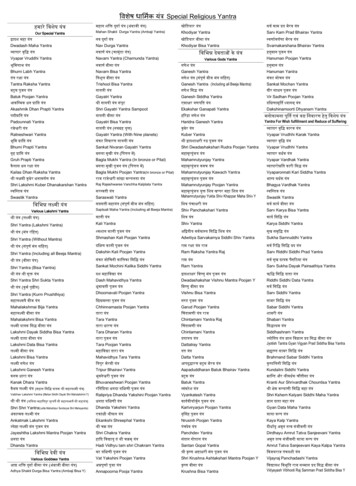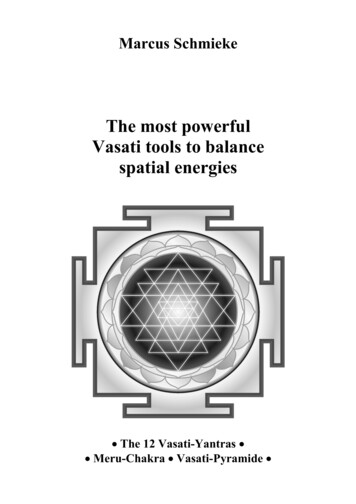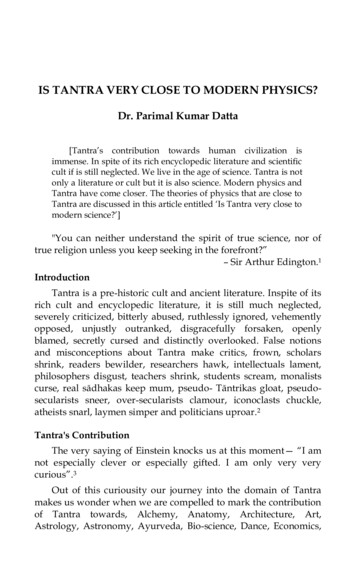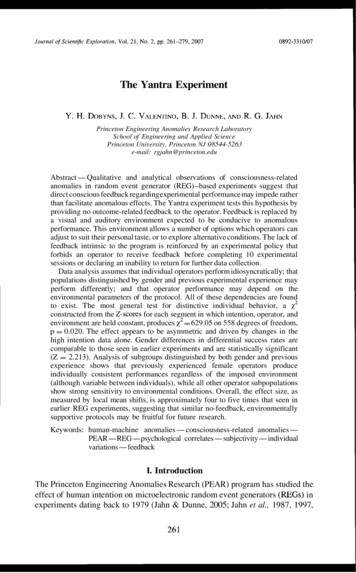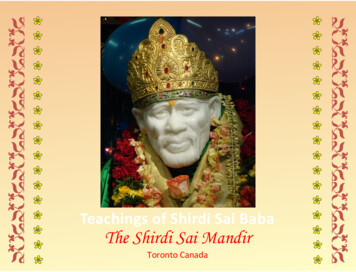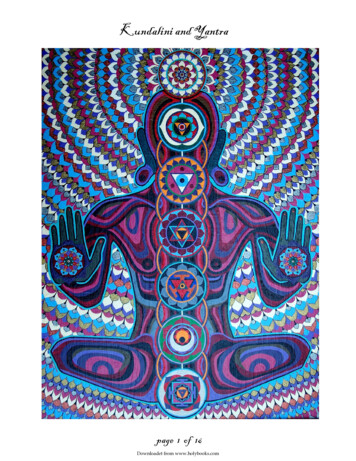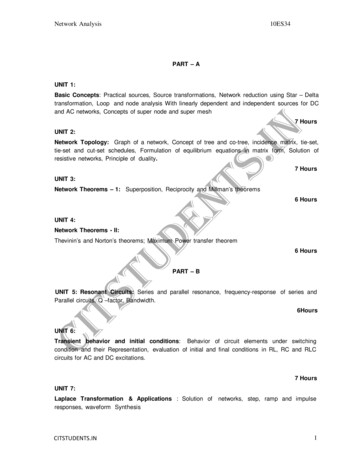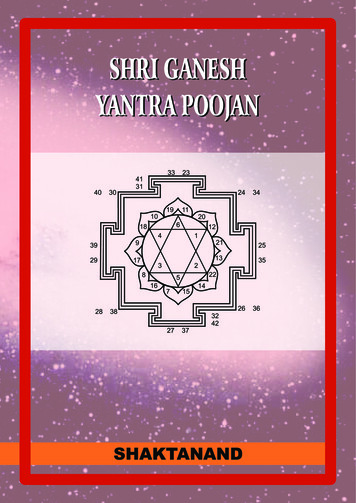
Transcription
SHRI GANESH YANTRA POOJANSHAKTANAND www.nirvanasage.com
Published by:Para Vidya Prakashan,# 3019, Sector - 27 D,Chandigarh-160019.U.T., India.Contact: shaktanandblogspot@gmail.comFirst Edition: May, 2019.Type setting and Printing:Mahindra's, Students‟ Store# 51, Panjab University,Sector - 11, Chandigarh-160011.e-copies available at :Address - www.nirvanasage.com
NIRVANA SAGE– Yantra TextS. NoMahavidya TextPage No.1.Ganesh Yantra Poojan52.108 names19***********************
IntroductionMantra-Yantra-Tantra, all three combine together to represent thecompleteness of any Sadhana. The real meaning of the mantra isrepresented in the whole cosmos and thatsame meaning is represented inour body too. That is why Brahmrishi Vashishth said, 'Yatha Pinde tathaBrahmande' i.e. as is the body, same is the Cosmos.Crossing the body and the Cosmos one approaches the Bindu which is thecoordinator of Yantra.That Bindu itself is the brahm. Thus entering from the Bhoopur, realizingthe respective deities of Mandal, Shatkone, Trikone etc., one can reach thatBindu. This Bindu itself is Brahm.Hence remembering the Mantra, for doing the sadhana of the Yantrathrough the method laid down by Tantra,to realize the actual form ofYantra, is the real meaning of Sadhana. For this, one should practiceYantra-sadhana under the guidance of a qualified guide.Shri Suneet Joshi (Suyoganand Nath) has brought forward this book as amatchless present for all the Sadhaks.This is beneficial not only for studying purpose but for actual practice too.Sadhana is a thing of experience and not of argumentation. “ShradhavaanLabhate Gyanam”.Iti Sham.Jiveshwar Mishrah (Abhayanand).Vaishakh Shukla Paksha Dwadashi Samvat 2076, Vikrami.
ForewordWithout Yantra, Mantra and Tantra Prasad(fruit) of the devta is extremelydifficult. Yantra is the gross body of the Devta/divinity. Poojan, Nyas andMudra etc. are the tantra of the devta. Mantra is the causal body of thedevta. Devtas are under the control of Yantra, Tantra and Mantra.Ath Yantram Pravakshayami Devta Suprasadhanam,अथ मंत्रभ ् प्रवऺमामभ दे वता सुप्रसाधनभ ्,Yantra Bina Devta Ch Na Prasidati Sarvada.मंत्र बफना दे वता च न प्रसीदतत सववदा ।Thus one can say one should perform yantra poojan for pleasing thedevta.Yantra (मंत्र) is a mixture of two letters Yam (मं) and Tra (त्र). „Yam (मं)‟represents a support or base while „tra‟ which comes from „Tra (त्र)‟ dhatuand represents freedom from bondage. Yam is the lord of death hence wecan infer that yantra is that which provides us liberation from the bondageof life and death. Yantra is a mechanism, a machine, which works.Whenever we look at any object first we see its form which is outermanifestation and then we try to understand its symbolism which is innermanifestation. Thus we can say that a yantra represents a symbol ofconcentration. Like our houses are made as per specific designs and ownerlives in it at a particular point and to access his location a specific path wayis to be followed. Same is the case with yantras. Yantras are the geometricalrepresentation of the dwelling places of divinities or we can say that it is ageometrical representation of the energy of a specific divinity. In tantraelaborate procedures are laid down to access the yantra, the basic being theguards of the four doors. First, one has to make friends with one of them togain entry in to it. All the four are having different nature and hence theirrespective sadhanas, mantras are also mbols like Bindu. Triangleofacombinationspecific, six sided Star, Circles, 8Petal/12/16/64 ( ,) etc. petal lotuses with a square periphery allaround with four gates in the four directions. This periphery iscalled Bhoopur() and is generally made up of three equidistant lines.The other aspect of yantra is called Mantra. Mantra is said to be the keywith which one can enter in to that geometrical formation of yantra tounravel the inherent energy in it which is the specific devta whethermasculine or feminine. Scientifically we can say that a mantra comprises of–1–
seed syllables of Hindi varnmala which are chanted from specific locationof the mouth cavity. Each alphabet pertains to a specific location for itschanting carries a unique energy to it (for details read „Matrika ShaktiVilas‟). Repeated chanting of that frequency generates a thresh hold valueof specific energy which helps to open the lock of the yantra to gain accessin to it.As per tantra, coming to the concept of cosmic creation, it is said that atstart there was nothing and everything was at complete rest which wasexplained by a state of Param Shunya (zero). This param shunya thoughseemed to be empty but there were two primordial powers, Shiv (pureintelligence) and Shakti (pure dynamism) existing together in a perfectequanimity. Sensing the desire of the Shiv (pure intelligence) for creation,Shakti (pure dynamism) moved, thus a point got created in that perfectstillness or Shunya. This point was called a Bindu. Thus from the state ofsuper conscious state of Shiv and Shakti, a visual state of bindu got created.We can say that from subtle, a gross expression was established. When thewave of energy moved out of this bindu a line got created. The intersectionof the lines created a triangle, the first cosmic womb from where evolutionprocess towards manifestation of the world started. Raudri, Jyeshtha,Vama represented the three sides of this triangle which co- joined withVaikhari, Madhyama and Pashyanti while the central bindu representsPara.The above is surrounded by a square generally, known as Bhoopur whichcomprises of a combination of horizontal and vertical lines representingstatic and dynamic forces. As it is said that a sadhak experiences the realityin the chidakash (space between the brows) in the form of a circle while ayogi experiences it in the form of a square which is more evolved andbalanced. In the three lines of the Bhoopur, three sets of divinities dwell. Inthe middle line devtas of all the ten directions dwell in their specificdirection i.e. Indra (East)1, Agni (S-E)2,Yam (S)3, Nairitt (S-W)4, Varun (W)5,Vayu (NW)6, Kuber (N)7, N-E (Ishan)8, N-Brahm (N-NE)9, Anant(SW)10 respectively; in the inner line all the four dwarpaal or gate keepersreside i.e. Batuk-(South), Ganesh-(West), Yogini-(North), Kshetarpal(East); while in the outermost line ten armaments of the ten directiondivinities i.e. Vajra1, Shakti2, Dand3, Khadag4, Paash5, Ankush6,Gada7,Trident8, Padm9 and Chakra10 respectively are located to guard thefort of yantra so that no unqualified should enter it.Generally Shiva, the pure consciousness, intelligence and support isrepresented by an upward pointing triangle while Shakti, the pure–2–
dynamism, descent of energy is represented by a downward pointingtriangle. When these two superimpose, a six sided star is created. Thecreation is said to be formed with coming together of Sun, Moon and Firei.e. Surya, Chandra and Agni respectively. The matrika shaktis are dividedin to vowels and consonants. There are 16 vowels in Hindi languagerepresented by 16 Kalas of the Moon and 25 consonants of Surya and 9kalas of Agni (Fire) are there. Apart from this sometime8 petal lotus is alsomade which pertains to five elements of Space, Air, Fire, Water, Earth andthree other namely Mind (भन), Intellect (cqf)), Ego (चचत) respectively andsometimes 8 shaktis like Brahmi etc. reside there.The various geometrical formations in the yantra represent various Avaranfor poojan of different divinities or forces. This poojan is done generally intwo ways. One is called Srishti Kram (Creation) and other is called SangharKram (Dissolution). When we move from Bindu towards bhoopur it iscalled Srishti Kram and when we move from Bhoopur towards the Bindu itis called Srishti Kram. The Devi resides in the bindu. As per swabhav onefollows either of the two paths. Another important thing to be under stoodin case of yantras is the direction. Normally in a formation drawn on apaper, top corner is taken as North and right hand side is taken as East. Butin case of yantra it is rotated through 90 degrees in anti-clockwise direction.So the paper North becomes East of the Yantra and other directions alsorotate accordingly. Generally 8 directions are represented on the yantrasbut some time ten directions are also given on it. The 8 directions areNorth, South, East and West, N-E, S-E, S-W, W-N. The 9th and 10thdirection come in-between N-NE and S-SW in case of general directions ona paper but between E-NE and W-SW in case of yantra.The yantras bought from the market are on copper plates but many times asadhak has to draw them with his or her hand. In that case, bark of a bhojpatra is used. A pen made out of the pomegranate tree twig is taken todraw the yantra on a specific time. A procedure is also mentioned forgetting the apple tree twig which is being shared below. The idea herebeing to share as much knowledge as possible, with all the sinceresadhaks. Go to the pomegranate tree to request for a twig for making penfor drawing a yantra on so and so date. Chant the following sloka in frontof it and light a dhoop under it.Om! Vetalaashch Pishachashch Rakshashch Sari Saripa,(ॐ वेताराश्च पऩशाचाश्च याऺसाश्च सयीसऩृ ा)Apsarpantu Te Sarve Vrikha Asmaad Shivagya.(अऩसऩवन्तु ते सवे वऺृ �)–3–
Offer some money, jiggery, rice, supari, roli at its roots and namaskaar.ॐ नभस्ते अभतृ सम्बूते फरवीमव पववपितनफरभामीश्च भे दे हह ऩाऩन्भे त्राहह दयू तः ।Thus tell the tree on which day and date you are coming to take the twigfrom it.On the appointed day, chanting the mantra Om! Hreem Chande Hum PhatSwaha (ॐ ह्ीं चण्डे हूं पट् स्वाहा ) take the twig by breaking it with hand orwith a stone and not with any blade etc.Another important part is the ink which is to be used for making theyantra. It can be broadly divided in to two categories, masculine devta andfeminine devta.For masculine devta we should use Agar, Tagar, Kesar, Kastoori, RedChandan, White Chandan, Gorochan, Hathimad, Rose water;While for feminine devta we should use Chandan, Agar, Haldi, Kumkum,Gorochan, Shilajeet, Jatamaansi, Karpoor.Further, what kind of work we require to do with the yantra, decides as towhich day it should be made, sitting in which direction or which asan, inwhich season etc. Right now we are not going in to all those details.Though, tantra practitioners researched on it exhaustively.Moving from this outward manifestation, a sadhak graduates to the higherinner plane or realm. For him/her this very body becomes the Yantra andthe soul living within, the adya Shakti, the primordial power or the dearIsht devi. Depending upon his/ her dhyan, yearning, the inner energytakes that particular form and gives darshan. Generally, darshan isachieved in the chidakash, a space between the two eye brows. A sadhakgets darshan their in the form of a circle which is limited while a yogi getsa darshan their in the form of a square which is unlimited, as his Kundliniis fully awake right from his birth.Prostrating, One sincerely prays to the Mother, that every ardent sadhak,devotee may be blessed to reach the state of evolution where all yogisdwell and hence fulfil the purpose of the borth in this human form.Date: 26th March, 2019.ShaktanandChandigarh.–4–
Shri Ganpati Yantra PoojanBeejapoor Gade Ikshu Karmukruja Chakrabj Paashotpalबीजापूर गदे क्षु कामुुकरूजा चक्राब्ज पाशोतपल,Brihya Grasv Vishaan Ratna Kalash Prodyat-Karambhoruhah,व्रीहा ग्रस्व विषाण रत्न कलश �ूहा:,Dhyayeyo Vallabhaya Sapadm Karya Shlisht-Ujjwalad-Bhooshaya,ध्येयो िल्लभया सपद्म करया श्लिष्टोज्जिलद् भूषया,Vishvopatti Vipatti Sansthiti Karo Vighnesh Ishtardhdah.विश्वोत्पवत विपवत संश्लथथवत करो विघ्नेश इष्टाथुदः)–5–
The whole creation came out of Agni and Som. Agni represents Shiva while Som/Ras is represented by Shakti. Whole of the creation is full of Fire and Ras. FromAgni /fire comes Ras and with Ras only the fire increases. Fire goes upwards andRas or Som travels downward. Agni going up transforms to Ras while Rascoming down transforms to Agni. As by coming together of the two, the wholecosmos is created, in the same way from Shiva and Shakti Ganesh is created. It issaid that the whole world comes out of him and also ends in him.He is Ek dant, four armed with Paash, Ankush, Dant and Varmudra, red hued,pot bellied, smeared with red chandan and his poojan done with red flowers. Heis also a vedic devta but his name there is refered to as Ganpati or Brahnaspati. Inpuranas, he is referred to as Ganesh. Ganpati means who is father of all the ganas.Generally Gana means a community but here it means community of divines,group of all the elements. His face is of an elephant while rest of the body is likethat of humans. An elephant is called Gaj in Sanskrit. „Ga‟ represents the statewhich Yogis achieves in Samadhi and „Ja‟indicates the source of creation. Thus hishead represents brahm while the lower part is called Sagun brahm. Kartikeya ishis brother, Ridhi-Sidhi and Budhi are his wives. Ganesh represents waterelement which has four qualities Sound, Touch, Form and Ras respectively. Theymay also represent four states through which creation takes place i.e Swedaj,Andaj, Udbhij and Jarayuj. His trunk which is not straight but curved representsthe maya which is difficult to transcend. Hence he is called Vakrtund. His ears arelike the Shoorp which separate the rice from the chaff. Thus he removes theignorance of his devotees. He is Vighnaraaj as he removes the obstacles of all thedevotees. His vehicle is mouse which represents that he guides the devotees livingin their hearts. He likes Shami leaves, Durva and and sweet laddus as offeringduring poojan.–6–
–7–
Shri Ganesh Yantra Poojan(As Per Mantra Maharnav)Yantra: Bindu, Star-6 sided, Lotus-8 petals, Bhoopur.Dhyan:Hastindra Choodmarunchaya TrinetramRasaDashlishtam Priyaya Sa Padmkarya Sankasthaya Sangatam,Beejapoor Gada Dhanuh Trishikh Yuk Chakrabj Pashotpalam,Brihyagra Sva Vishaan Ratna Kalashaan Hastair Vahantam Bhaje.Patra Establishment: Draw a downward pointing triangle in front ontheleft hand side, starting from I to 2 to 3 without taking the finger off fromthe ground with red chandan or kumkum. Do poojan of various shaktiswith flower petals at different places in the triangle as written below:At 1 :Om! Anantaya Namah; at 2 - Om! Nagaya Namah; at 3 - Om! KoormayaNamah and at 4 – Om! Shaktadharshaktaye Namah.Put the copper pot over the point 4, with astra mudra say phat over it.Chanting Om fill it with water.With Ankush Mudra attract the waters of various sacred rivers in to thepatra from the light of the Sun in the space, sayingOm! Krom Gange ch Yamune Godavari Narmade Sindhu Kaveri,Brhamndo Udra Teerthani Kare Sprishtava Te Rave,Tein Satyen Mein Deva Teertahm Dehi Diwakara.Rotate Dhenu Mudra over the pot 8 times, show Matasya mudra ovet it.With flower petals do the poojan of Surya kala, Som Kala and Agni kala inits water.–8–
Om! Ete Gandh Pushpe Ram Vanhi Mandalaya dash Kalatmane Namah,Om! Ete Gandh Pushpe Am Ark Mandalaya Dwadash Kalatmane Namah,Om! Ete Gandh Pushpe Om Som Mandalaya Shodash Kalatmane Namah.Again show Dhenu Mudra, Conch Mudra and Yoni mudra to the pot. It isnow ready to be used.Asan Establishment:Draw a Downward pointing triangle with red chandan/kumkum. Performsame poojan as done in the point 1-3 as above but in the point no 4 sayAdharshakti Kamalasnaya Namah. Spread the asan over it.Om! Asya Shri Asan Mahamantrasya Prithviyah Meruprishtha Rishih,Sutlam Chandah, Koormo Devta, Asnopvesane Viniyogah.Prithvi tvaya Dhrita loka Devi Tvam Vishnu na dhrita,Tvam Ch Dharya Ma Devi, PaviStrim Kuru Ch Asnam.Yogasnaya Namah, Veerasanaya Namah, Sharasanaya Namah.Om! Hrim SStrim Hum Om! Hrim Adhar Shakti Kamalasanaya Namah.Take three sips of water form the samanya argh and drink from the base ofthe right hand palm without making any sound with following mantra,visualizing that the water sips are cleasing Atma tattva, Vidya Tattva andShiv respectively.Om! Atma Tattva Shodhayami Namah,Om! Vidya Tattva Shodhayami Namah,Om! Shiv Tattva Shodhayami Namah Swaha,And wash hands on the right side of the asan sayin Om! Sarv tattvaShodhyami Namah Swaha.Purification:a.Take water from the pot in the left palm and cover it with the right palmand chant following mantra,Om! Apvitra Pavitro Va Sarva Vastham Gatoh Pivah,Ya smared PundrikakshamSa Abhyantarah Shuchi. Om! Punatu Pundrikakshah, Punatu PundrikakshahPunatuh.–9–
Sprinkle the water with a flower holding it with Tattva mudra of the righthand over all the people, all the articles being utilized in the poojan andself.b.Self (Bhoot Shudhi)Our body is made up of five elements and cleansing of all these is calledBhoot Shudhi. There are many short and elaborate systems for thismentioned in the different scriptures. Here we will use a simple methodthrough the cleanising of the first five chakras which represent the fiveelements in our body too.Sit in a mefitative posture on the asan. Breath in and out horizontallythrough Mooladhar chakra three times and chant LAM beej.Breath three times horizontally through Swadhishthan Chakra three timesand chant Vam beej.Breath three times horizontally through Manipur Chakra three times andchant Ram beej.Breath three times horizontally through Anahat Chakra three times andchant Yam beej.Breath three times horizontally through Vishudhi Chakra three times andchant Ham beej.Chant Ram beej and generate a blaze of fire in the stomach, increase it andburn the thumb sized paap purush there. Turn it to ashes.Repeat Yam beej and move the ashed ot the space of mooladhar chakra.Chant Vam beej and knead it in to a ball.Chant Lam beej and turn it golden. Inhaling and exhaling increase its sizeto cover the whole subtle body. Visualize the form of Hiranyagarbha forcreation of new body. Regenerate Ether, Air, Fire, Water and Earthelements a new. Regenerate the gross body.With ankush mudra attract the pranic energy from the cosmos andtouching with tattva mudra (transferring pranic energy into the yantra)establish it into the new body with following mantra,– 10 –
Om! Aam (आं) Hrim (ह्ीं) Krom (क्रों)Yam (मं), Ram (यं ), Lam (रं), Vam (वं),Sam (शं),ṣa (षं),ṡa (सं), Ham (हं ) Hamsa Soham, mam jivah eha Sthita.Om! Aam (आं) Hrim (ह्ीं) Krom (क्रों) Yam (मं), Ram (यं ), Lam (रं), Vam (वं),Sam (शं),ṣa (षं),ṡa (सं), Ham (हं ) Hamsa Soham Mam Sarv Indriyani EhaSthitani.Om! Aam (आं) Hrim (ह्ीं) Krom (क्रों) Yam (मं), Ram (यं ), Lam (रं), Vam (वं),Sam (शं),ṣa (षं),ṡa (सं), Ham (हं ) Hamsa Soham Mam Vang, Manah,Chakshu, Kshotra, Tvak, Ghran, Pran, Eha Gatya Sukham ChiramTishthantu Svaha.Raise the Kundlini to meet the Shiva in Sahasrar and bring it back to themooladhar.Strike the left heel on the left side of the asan three times.Clap three times downwards.Look around with strong Gaze to make all the bad spirits in the spacemove away.Samkalp:Om! Tat Sad Adya Parmatman Agya Pravart Manasya, AMUK Samvatsare,Shri Shwevarah Kalpe, Jambu Dwipe, Bharat Khande, AMUK Pradeshe,AMUK Sthane AMUK Mase (month), AMUK Gotrotpanne (gotra in whichone is born, use Kashyap Gotra if gotra not known) AMUK Sharma Aham(Name), Shri Ganpati Prasad Sidhi Dwara Sarv Abhishth SidhyarthamYatha Shakti, Yatha Gyanen, Yatha Sambhavit Upchar Dravyai SangAvarnaih, Shri Ganpati Poojan aham Krishaye. Tatha Ch PoojadhikaarSidhyartham Sharir Shudhyartham Ch Bhoot Shudhyadi MoolmantramNyasadikam Karishaye.Viniyog:Om! Asya Shri Ganesh Mantrasya, Bhargav Rishih, Anushtup Chandah,Vighnesho Devta, Vam Beejam, Yam Shaktih, Mam Abhishth Sidhaye JapeViniyogah.Rishih Nyas:Om! Bhargavarshay Namah Shirsi (Head),– 11 –
Om! Anushtup Chandase Namah Mukhe (mouth),Om! Vighnesh Devtayai Namah Hridi (Heart),Om! Vam Beejaye Namah Guhaye (Anus),Om! Yam Shaktaye Namah Paadyoh (Feet),Om! Viniyogaya Namah Sarvange (Whole Body).Kar Nyas:Om! Vam Namah Angushthabhyam Namah,Om! Kram Namah Tarjanibhyam Namah,Om! Tum Namah Madhyamabhyam Namah,Om! Daam Namah Anamikabhyam Namah,Om! Yam Namah Kanishthabhyam Namah,Om! Hum Namah Kartalkar Prishthabhyam Namah.Ang Nyas:Om! Vam Namah Hridyaya Namah,Om! Kram Namah Shirsi Swaha,Om! Tum Namah Shikhaye Vashat,Om! Daam Namah Kavchaya Hum,Om! Yam Namah Netra Treyaya Vaushat,Om! Hum Namah Astraaya Phat.Varna Nyas:Om! Vam Namah Bhrumadhye (Eyebrow centre),Om! Kram Namah Kanthe (Neck),Om! Tum Namah Hridye (Heart),Om! Daam Namah Nabhau (Navel),Om! Yam Namah Linge (Ongan of Urination),Om! Hum Namah Padyoh (Feet).Nyas:Karang Nyas:Shreem (श्ीं) Hreem (ह्ीं) Kleem (करीं) Glaum (ग्रौं) Gam (गं) Gaam (गां)Angushtha bhyam Namah.Shreem (श्ीं) Hreem (ह्ीं) Kleem (करीं) Glaum (ग्रौं) Gam (गं) Geem (गीं)Tarjanibhyam Namah.– 12 –
Shreem (श्ीं) Hreem (ह्ीं) Kleem (करीं) Glaum (ग्रौं) Gam (गं) Goom (गूं)Madhyamabhyam Namah.Shreem (श्ीं) Hreem (ह्ीं) Kleem (करीं) Glaum (ग्रौं) Gam (गं) Gaim (गैं)Anamaikabhyam Namah.Shreem (श्ीं) Hreem (ह्ीं) Kleem (करीं) Glaum (ग्रौं) Gam (गं) Gaum (गौं)Kanishthabhyam Namah.Shreem (श्ीं) Hreem (ह्ीं) Kleem (करीं) Glaum (ग्रौं) Gam (गं) Gah (गः)Karprishthabhyam Namah.1st Avaran Poojan:{Around the Bindu (a-e)}:a. Om! Shriyai (चश्मै) Sah (स:) Shri Patye (श्ीऩतमे) Namah: East of Devtab. Om! Gauryai (गौमै) Sah (स:) Gauripatye Namah: South of Devta.c. Om! Ratyai (यत्मै) Sah (स:) Rati Patye Namah: West of Devta.d. Om! Mahyai (भह्मै) Namah, Varahaya Namah: North of Devta.e. Om Luxmi Sahit Gan Nayakaya Namah: In front of Devta.Offering flowers and rice on the Yantra chant the following,Abhisht Siddhim Mei Dehi Sharnagata Vatsale,Bhaktaya Samarpaye Tubhyam Pratham Avaran Archanam.2nd Avaran Poojan:In the six sided Star:1. Om! Vam Hridyaya Namah, Hridya Shri Padukaam PoojayamiTarpayami Namah.2. Om! Kraam Shirsi Swaha, Shirsi Shri Padukaam Poojayami TarpayamiNamah.3. Om! Tum Shikhaye Vashat, Shikha Shri Padukaam PoojayamiTarpayami Namah.– 13 –
4. Om! Daam Kavchaya Hum, Kavach Shri Padukaam PoojayamiTarpayami Namah.5. Om! Yam Netra Treyaya Vaushat, Netra Shri Padukaam PoojayamiTarpayami Namah.6. Om! Hum Astraaya, Phat. Astra Shri Padukaam Poojayami TarpayamiNamah.Offering flowers and rice on the Yantra chant the following,Abhisht Siddhim Mei Dehi Sharnagata Vatsale,Bhaktaya Samarpaye Tubhyam Dwitya Avaran Archanam.3rd Avaran Poojan:In the 8 Petal Lotus:In the front of the lotus petals perform the poojan of the following07. Om! Vidyayai Namah, Vidya Shri Padukaam Poojayami TarmapayamiNamah.08. Om! Vidhatrayai Namah, Vidhatri Shri Padukaam PoojayamiTarmapayami Namah.09. Om! Bhogdayai Namah, Bhogada Shri Padukaam PoojayamiTarmapayami Namah.10. Om! Vighan Ghatinyai Namah, Vighan Ghati Shri PadukaamPoojayami Tarmapayami Namah.11. Om! Nidhi Pradeepayai Namah, Nidhi Pradeepa Shri PadukaamPoojayami Tarmapayami Namah.12. Om! Paap Ghanyai Namah, Paap Ghani Shri Padukaam PoojayamiTarmapayami Namah.13. Om! Punyayai Namah, Punya Shri Padukaam Poojayami TarmapayamiNamah.14. Om! Shashi Prabhayai Namah, Shashi Prabha Shri PadukaamPoojayami Tarmapayami Namah.– 14 –
In the front ends of the 8 petals perform the poojan of the following,15. Om! Vakratundaya Namah, Vakratund Shri Padukaam PoojayamiTarpayami Namah.16. Om! Ek DranshtayaNamah, Ek Dransht Shri Padukaam PoojayamiTarpayami Namah.17. Om! MahodarayaNamah, Mahodar Shri Padukaam PoojayamiTarpayami Namah.18. Om! HastomukhayaNamah, Hastomukh Shri Padukaam PoojayamiTarpayami Namah.19. Om! LambodarayNamah, Lambodar Shri Padukaam PoojayamiTarpayami Namah.20. Om! VikatayaNamah, Vikat Shri Padukaam Poojayami TarpayamiNamah.21. Om! Vighna RajayaNamah, Vighna Raj Shri Padukaam PoojayamiTarpayami Namah.22. Om! Dhoomra VarnayaNamah, Dhoomra Varna Shri PadukaamPoojayami Tarpayami Namah.Offering flowers and rice on the Yantra chant the following,Abhisht Siddhim Mei Dehi Sharnagata Vatsale,Bhaktaya Samarpaye Tubhyam Tritya Avaran Archanam.4th Avaran Poojan:Ist Inner Line of Bhoopur: (4 Gate keepers/ Dwaarpaals):23. Om! Gam Ganpataye Namah, Ganpati Shri Padukaam PoojayamiTarpayami Namah24. Om! Bam Batuk Bhairavaya Namah, Bhairav Shri Padukaam PoojayamiTarpayami Namah.25. Om! Yam Yoginibhyo Namah, Yogini Shree Padukaam PoojayamiTarpayami Namah.26. Om! Ksham Kshetrapaalaya Namah, Kshetrapaal Shree PadukaamPoojayami Tarpayami Namah.– 15 –
2nd Middle Line of Bhoopur (10 Direction Divinities):Perform the poojan of direction devtas in the square as shown below:27. Om! Lam Indradya Devadhipatye Sayudhaya Savahanaya SaparivarayaNamah. Indra Shri Padukaam Poojayami Tarpayami Namah.28. Om! Ram Agnaye Tejodhipatye Sayudhaya Savahanaya SaparivarayaNamah. Agni Shri Padukaam Poojayami Tarpayami Namah.29. Om! Maam Yamaya Pretadhipatye Sayudhaya SavahanayaSaparivaraya Namah. Pret Shri Padukaam Poojayami Tarpayami Namah.30. Om! Ksham Nirrittaye Rakshodhipatye Sayudhaya SavahanayaSaparivaraya Namah. Nairitt Shri Padukaam Poojayami TarpayamiNamah.31. Om! Vam Varunaya Jaladhipatye Sayudhaya Savahanaya SaparivarayaNamah. Varun Shri Padukaam Poojayami Tarpayami Namah.32. Om! Yam Vayave Pranadhipatye Sayudhaya Savahanaya SaparivarayaNamah. Vayu Shri Padukaam Poojayami Tarpayami Namah.33. Om! Saum Somaye Taradhipatye Sayudhaya Savahanaya SaparivarayaNamah. Som Shri Padukaam Poojayami Tarpayami Namah.34. Om! Ham Ishanaye Ganadhipatye Sayudhaya SavahanayaSaparivaraya Namah. Ishan Shri Padukaam Poojayami Tarpayami Namah.Now between East and Ishaan, perform the poojan of Brahma as below:35. Om! Aam Brahmane Prajadhipatye Sayudhaya SavahanayaSaparivaraya Namah. Brahm Shri Padukaam Poojayami TarpayamiNamah.Now between Varun and Nairitt, perform the Poojan of Anant as follows:36. Om! Hreem Anantaya Naagadhipatye Sayudhaya SavahanayaSaparivaraya Namah, Anant Shri Padukaam Poojayami TarpayamiNamah.3rd Outer Line of Bhoopur- (10 Ayudh):Now perform the poojan of ten astras of the ten direction devtas as givenbelow with flower petals, rice etc starting from East direction,– 16 –
37. Om! Vam (वं) Vajraye Namah, Vam (वं) Vajra Shri Padukaam PoojayamiTarpayami Namah.38. Om! Sham (शं) Shaktaye Namah, Sham (शं) Shakti Shri PadukaamPoojayami Tarpayami Namah.39. Om! Dam (दं ) Dandaye Namah, Dam (दं ) Dand Shri PadukaamPoojayami Tarpayami Namah.40. Om! Kham (खं) Khdagaye Namah, Kham (खं) Khadag Shri PadukaamPoojayami Tarpayami Namah.41. Om! Paam (ऩं) Paashaye Namah, Paam (ऩं) Paash Shri PadukaamPoojayami Tarpayami Namah.42. Om! Am (अं) Ankushaya Namah, Am (अं) Ankush Shri PadukaamPoojayami Tarpayami Namah.43. Om! Gam (गं) Gadaya Namah, Gam (गं) Gada Shri PadukaamPoojayami Tarpayami Namah.44. Om! Trim (बत्रं) Trishoolaya Namah, Trim (बत्रं) Trishool Shri PadukaamPoojayami Tarpayami Namah.45. Om! Pam (ऩं) Padmaya Namah, Pam (ऩं) Padm Shri PadukaamPoojayami Tarpayami Namah.46. Om! Cham (चं) Chakray Namah, Cham (चं) Chakra Shri PadukaamPoojayami Tarpayami Namah.Offerinf flowers and rice on the Yantra, say the followingAbhisht Siddhim Mei Dehi Sharnagata Vatsale,Bhaktaya Samarpaye Tubhyam Chaturth Avaran Archanam.Aarartikam Kuryat (Do Her Aarti).After Aarti, Take three circumabulations of the Devi, offer pranam,prostrate in front of His and offer Kshama Prarthana as below:Avahanam Na Janami, Na Janami VisarjanamPoojanam Na Janami Kshamyataam Parmeshwara.– 17 –
Mantraheenam Kriyaaheenam Budhiheenam Maheshwara,Yat Poojitam Maya Deva Paripoornam Tadastu Mei.Guhayati Guhya Goptri, Tvam Ghrina smat Kritam Japan,Sidhi Bhavtu Ma Devi, Tvat Prasadan Maheshwara.Thus end the Yantra Poojan of Shri Ganesh Yantra.*********************– 18 –
108 names of Ganpati:Om! Ganeshwaraya Namah1Om! Gankridaya Namah2Om! Ganpataye Namah3Om! Vishvakartaya Namah4Om! Vishvamukhaya Namah5Om! Durjaya Namah6Om! Dhoorjayaya Namah7Om! Jayaya Namah8Om! Swaroopaya Namah9Om! Sarv Netradhi Vasaya Namah10Om! Verrasan Ashrayah11Om! Yogadhiph Taarkasthaya Namah12Om! Purushaya Namah13Om! Gajkarnaya Namah14Om! Chitrankaya Namah15Om! Shyam Dashnaya Namah16Om! Bhaal Chandraya Namah17Om! Chaturbhujaya Namah18Om! Shambhave Namah19Om! Tejaya Namah20Om! Yajyakaya Namah21Om! Sarvatmane Namah22Om! Saam Brinhitaya Namah23Om! Achalansaya Namah24Om! Vyom Nabhye Namah25Om! Kalpdrum Vanalaya Namah26Om! Nimn Nabhye Namah27Om! Sthool Kukshaya Namah28Om! Peen Vakshaya Namah29Om! Brihad Bhujaya30Om! Peen Skandhaya Namah31Om! Kambu Kanthge Namah32Om! Lamboshthaya Namah33Om! Lamb Nasikaya Namah34Om! Sampoornaya Namah35Om! Sarv Avyavaya Namah36Om! Sarv Laxan Laxitaya Namah37Om! Ikshu Chaap Dharaya Namah38Om! Shooline Namah39Om! Kantaya Namah40Om! Kandali Ashraya Namah41Om! Akshmala Dharaya Namah42Om! Gyan Mudravaanaya Namah43Om! Vijyavahaya Namah44Om! Kamini Kaamnaya Namah45Om! Kaammalinye Namah46Om! Kelilalite Namah47Om! Amogh Sidhiradharaya Namah48Om! Adhaar Adhaya Varjitaya Namah49Om! Indivardal Shyamaya Namah50Om! Indu Mandal Nirmalaya Namah51Om! Karm Saakshaye Namah52Om! Karm Kartaye Namah53Om! Karm Akarm Phal Pradaya Namah54Om! Kamandal Dharaya Namah55Om! Kalpaya Namah56Om! Kapardine Namah57Om! Kati Sutra Bhritaya Namah58Om! Karunya Namah Namah59Om! Kapilaya Namah60Om! Guhya Gamnaya Namah61Om! Guhashaye Namah62Om! Guhabdhisthaya Namah63Om! Ghatkumbhaya Namah64Om! Ghatodharaya Namah65Om! Poor Anandaya Namah66Om! Paranandaya Namah67Om! Dhandaya Namah68Om! Dharnidharaya Namah69Om! Brihatanaya Namah70Om! Brahm Paraya Namah71Om! Brhamanaya Namah72Om! Brahmvitpriyaya Namah73Om! Bhavya Namah74Om! Bhootalaya Namah75Om! Bhog Dataya Namah76Om! Maha Manaya Namah77Om! Varenyo Namah78Om! Vaam Devashchaya Namah79Om! Vandyo Namah80Om! Vajr Nivaranaya Namah81Om! Vishwa Kartaya Namah82Om! Vishwa Chakshur Havnaya Namah83Om! Havya Kavya Bhukaya Namah84Om! Svatantraya Namah85Om! Satya Sankalpaya Namah86Om! Saubhagya Vardhanaya Namah87Om! Kirtidaya Namah88Om! Shook Harine Namah89Om! Trivarg Phal Dayakaya Namah90Om! Chaturbahave Namah91Om! Chatur Dantaya Namah92Om! Chaturthi Tithi Sambhavaya93Om! Sahasra Shirshaye Namah94Om! Purushaya Namah95Om! Sahasrakshaya Namah96Om! Sahsrapataya Namah97Om! Kaamroopaya Namah98Om! Dweep Rakshkaya Namah99Om! Kshetradhip
Mantra-Yantra-Tantra, all three combine together to represent the completeness of any Sadhana. The real meaning of the mantra is represented in the whole cosmos and thatsame meaning is represented in our body too. That is why Brahmrishi Vashishth said, 'Yatha Pinde
